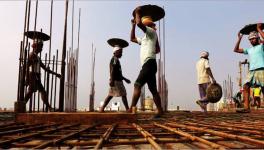The Perfect Storm Behind India’s Growing Hunger Crisis
Representational use only.
Economist Dipa Sinha, who teaches at the School of Liberal Studies at Ambedkar University, is actively involved with the Right to Food Campaign. In an interview with Newsclick, she explains why hunger is not an isolated concern but the result of a confluence of missteps. India has a food crisis because women and children lack a voice in policymaking, schemes that target them get designed badly or have their budgets cut by government, especially during a crisis. On top of it all, other vulnerable sections also get neglected, reducing incomes and blocking their route to access welfare schemes. Solidarity among workers and other movements that fight for the rights of workers and others is the solution, Sinha says. Edited excerpts.
Why is hunger rising across India? Which states are doing poorly, and what reasons would you attribute to this?
Multiple sources indicate an alarming situation of hunger and food insecurity in the country. Partial results of the NFHS-5, 2019, show malnutrition stagnating and childhood stunting worsening in many states. The pandemic made things worse for many. Unfortunately, we do not have nationally representative data to be sure of the present situation. However, slowing economic growth, stagnant rural wages, lower priority to welfare schemes such as Integrated Child Development Scheme (ICDS) and mid-day meals after the pandemic have created a crisis situation.
The spectre of hunger and starvation seems strange given the godowns are overflowing and wheat and crop production is steadily rising.
Absolutely. We had record high stocks in the Food Corporation of India (FCI) godowns throughout the pandemic. At least in cereals, the problem is not of lack of availability but of distribution. It is unethical to have this much hunger while the government stocks up grain. Even during the pandemic, the government did not universalise the Public Distribution System so that even those without ration cards could access subsidised or free foodgrains. There are many exclusions from the ration card lists, and the allocations are still based on the 2011 Census. Using the population projection estimates for 2021, we would need to add another ten crore [excluded] people to ration card lists to meet the mandate of the National Food Security Act (NFSA) to cover 75% of rural and 50% of the urban population.
Why do you think the government is apathetic on this issue?
We are food sufficient, with over 100 million tones of wheat and rice lying in Food Corporation of India godowns and yet people are hungry. It is a result of complete mismanagement of public policy. If the government procures grain at price ‘x’, but sells it at a lower cost to the poor, it is counted as a subsidy, [something that] raises the fiscal deficit. The government has fiscal deficit targets it does not want to cross, which would impact its ratings.
The government has attacked the methodology of the Global Hunger Index 2021, which positions India at 101 among 116 countries, even below 94 in 2020. Would you agree with the criticism?
The government’s criticism of the Global Hunger Index (GHI) is erroneous. The claim is that the index uses data from a phone-based Gallup survey, which is not valid. That said, it is also wrong to say that India’s rank has slipped from 94 to 101 because the GHI rankings are not comparable across years. So, we cannot say India’s ranking has worsened, but the GHI ranking does show that India’s ranking on hunger indicators is very poor. The GHI indicators represent overall food security, child malnutrition and child mortality.
Another criticism of the ranking is that it does not reflect hunger. However, we now widely understand chronic hunger as a reflection of whether a person is getting adequate and nutritious food that the body requires to be healthy—not just an indicator of whether a person is feeling hungry. The GHI indicators are appropriate to this understanding. All global indices have issues of comparison across countries and time, questions regarding the indicators used, their weightage and the quality of data. The GHI does too. The limited role they play is to highlight specific—and neglected—vital concerns, such as hunger in this case. They also give a broad picture of a country’s global standing.
You have said that the GHI underestimates rather than overestimates hunger because a more robust methodology would have lowered India’s results even more during the pandemic. What is your assertion based on?
Of the four indicators that the GHI uses, the one from the FAO on the proportion of the undernourished population, is an index in itself. Based on modelling data on consumption, availability, distribution patterns, and so on, it estimates the proportion of people who consume less than the minimum cut-off calories the FAO considers necessary for healthy living. Many have criticised that this cut-off as too low. There are also data quality and comparability issues concerning the data that goes into this estimate. Second, all the data in the GHI is from the pre-Covid period. We know from many ground reports that post-Covid, the situation is worse, so the accurate picture is probably worse than the report shows.
So the GHI should not have used the FAO data to determine the proportion of the Indian population with insufficient calorie intake. What other sources could it have tapped?
The GHI uses available data from official sources. India has not had a consumption expenditure survey that collects information on poverty and food consumption since 2011-12. There was a survey in 2017-18, but the government junked the report claiming data quality issues. That report got leaked to the media and showed that consumption expenditure in rural areas in 2017-18 had declined compared to 2011-12. But for official purposes, India still uses the 2011-12 report. The anthropometry [scientific study of the proportions and measurements of the human body] data from NFHS also goes back to 2015-16. After this period, India cut the budgets for welfare schemes and there was an economic slowdown. We will know the impact of these only after the NFHS-5 is released. Half of this survey was conducted just before the pandemic, and the other half between the first and second waves of Covid-19. We need the National Sample Survey Office (NSSO) to conduct the consumption expenditure survey—and maybe another round of NFHS—to get an accurate picture.
That said, of course India’s food crisis is amplifying. Hunger Watch conducted an in-person survey in October 2020 (after the first Covid-19 lockdown) of 4,000 rural and urban households in eleven states. These were of people from the informal sector. We found 77% of the more vulnerable sections of those interviewed said they were consuming less food than before. Further, 53% admitted their consumption of lentils and vegetables had decreased.
Most field surveys conducted towards the end of 2020 had about 60% of respondents say their food security is worse than before the pandemic. In addition, anecdotal evidence tells us the second wave hit the poor and vulnerable far more.
Why have our neighbours, Sri Lanka, Pakistan, Bangladesh and Nepal fared better even though their economies are much smaller than India’s?
Malnutrition has multiple determinants. There could be several reasons these countries are doing better, including higher investments in [policies and schemes for] women and children, health facilities, improved sanitation, etc. Bangladesh has made faster improvements in all of these in the last two decades compared with India.
Data on malnutrition, stunting, and wasting in children across Indian states, from the first phase of the National Family Health Survey 5 (2019-20), is extremely alarming. The government is cutting child nutrition programme budgets, so why don’t states protest aggressively?
In 2015, when the budgets were first cut, there were some protests, and then some budgets were revived. It is also true that the target populations of these schemes—women and children—do not have much of a voice and are unfortunately not a priority for governments.
Hunger relates directly to unemployment and inflation, both of which are steadily rising. Can you describe for readers what this means to the poor, who have growing difficulty making ends meet.
Inflation is rising across the board, but in particular, the prices of edible oils, the crucial cooking medium, have increased manifold. India’s unemployment levels are high, and on top of it, even those who find work are earning lower incomes because the wage rates are also low. Besides, people are not finding work for as many days as before. All this affects the quality of diet that people can consume. Even before the pandemic, studies showed that Indian diets are highly inadequate, heavily biased in favour of cereals, and are inadequate in nutritious animal-based proteins, pulses, vegetables and fruit.
The government says it launched schemes for the poorest sections to get subsidised food such as the Pradhan Mantri Garib Kalyan Anna Yojna (PMGKAY) and Atma Nirbhar Bharat Scheme (ANBS) in response to the pandemic. It claims around 32.2 million tonnes of foodgrain in 2020, and 32.8 million tonnes in 2021, were allocated free of cost to 80 crore people. How effective were these to control the incidence of hunger?
These schemes have helped those people who were able to access them. A significant number are out of the net of these welfare schemes and did not benefit from them. The efforts to include non-ration cardholders through community kitchens and temporary cards or coupons were very limited and restricted to a few states and lasted for a very short period. Given the high stocks of foodgrains, the government can do much more. Also, other schemes such as school meals and ICDS were non-functional throughout the pandemic, taking away a critical source of nutrition for children.
How did families and young children cope in these circumstances?
With Anganwadi centres closed, regular activities such as monitoring growth, and identifying and referring severely malnourished children are also disrupted. This disruption could have severe long-term implications for child nutrition. On paper, supplementary nutrition continued in the form of dry take-home rations, but their supplies have been irregular and inadequate to compensate for the extent of hunger in households. Reopening Anganwadi centres with all their services should be a priority. Further, it is not enough to return to the status quo ante. Additional efforts are needed, including improving the quality of the food in Anganwadis, and adding items such as egg, fruit, and so on. Some communities have a desperate hunger situation. We need concerted action from governments to provide immediate relief, strengthen and universalise public services (health, nutrition, education), and ensure employment-generating growth with decent wages and working conditions for all.
Anganwadi workers in Uttar Pradesh have not been paid honorariums for eight months. Is this the practice across states, and how do we pressurise governments to rectify this situation?
Anganwadi workers are not recognised as employees but treated as honorary workers. Their wages are meagre and not commensurate with the work they do. Irregular wage payments for Anganwadi workers is a problem in many states. The pandemic has made it worse. If we want good quality services for children and women, these workers need better pay. It is also their right as workers to get decent wages. Instead, their work is seen as an extension of women’s unpaid care work in households, which is often undermined.
Anganwadi workers’ unions are raising their voice in many states and some have managed to negotiate better terms of work. We hope that collective action by workers and solidarity and pressure from those who work for the rights of women and child who access and need the ICDS will make the state recognise their work and give them adequate remuneration. The conditions of ASHA workers is the same—and they, too, are an all-women cadre. Economist Jean Dreze has estimated that between 2015 and 2020, budgetary cuts in the ICDS and the Mid-Day Meal Scheme, in real terms, are to the extent of 25% of the program. Such cuts are bound to impact child nutrition adversely. This needs to be corrected along with the conditions of ASHA and Anganwadi workers.
(Rashme Sehgal is an independent journalist.)
Get the latest reports & analysis with people's perspective on Protests, movements & deep analytical videos, discussions of the current affairs in your Telegram app. Subscribe to NewsClick's Telegram channel & get Real-Time updates on stories, as they get published on our website.
























